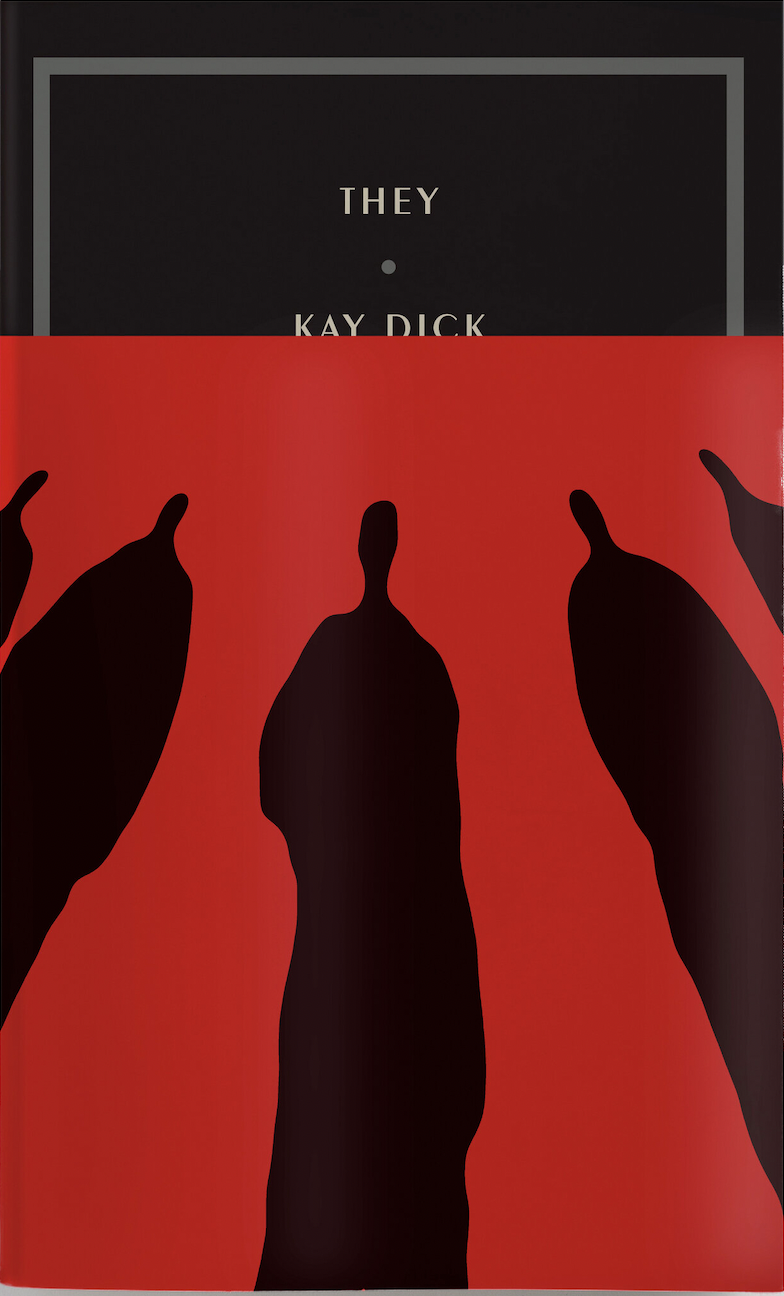
THE WRITER AND THE NOVELLA were both new to me: two plosive proper nouns and one personal pronoun, adding up to just three potent monosyllables. Kay Dick (1915–2001): an indelible name, especially for a lesbian. They: her ninth book (and sixth work of fiction), published in 1977, and best summed up, per text on this slim volume’s title page, as “a sequence of unease.”
Who are the “they” of They, a book broken into nine titled chapters, each of which could stand as an autonomous short story? The antecedent is never specified. But the actions of this anonymous, menacing group are concrete. These hordes—their number estimated to be “over a million, nearer two” —have been terrorizing England, prowling through the country on a mission to destroy all vestiges of art, culture, and individual thought. Unlike the book-destroying firemen of Fahrenheit 451, these malefic masses have no political affiliation; like the antagonists of Ray Bradbury’s 1953 classic, though, Dick’s “they” engage in ritual burnings and deploy television sets as narcotizing agents. They also gouge out the eyes of kittens and fling their furry corpses into gardens. Living along the coast, a small stronghold, which consists mainly of artists and artisans and includes the first-person narrator, try to resist these insidious guerrillas.
Who is the “I” of They? The name, gender, age, or race of the narrator is never revealed. What we do learn: the narrator is a writer, lives alone in a cottage with a dog, and may have stronger sexual desires for women than men. Claire, for example, one of the painters in this group of besieged dissidents, kisses the narrator, who later says, “I was ready to die for her.” Critic and editor Lucy Scholes, in her illuminating afterword for They—reissued by McNally Editions as part of a new series devoted to recherché books—declares this short novel to be “Dick’s most radically androgynous book.” The author, we discover, never really cared for either/or divisions. In a 1986 interview published in The Guardian, Scholes notes, Dick was forthright about her antipathy toward simple dualities: “I have certain prejudices and one of them is that I cannot bear apartheid of any kind—class, colour or sex. Gender is of no bloody account.” (Dick was practiced in the use of gender as masquerade. Shortly after becoming, at the age of twenty-six, the first woman director of an English publishing house, she was made the editor—using the pen name Edward Lane—of The Windmill, a highly regarded literary magazine.)
Like all robust allegories, They grants the reader the freedom to imagine any number of vivid referents for the opaque. While reading Dick’s novella, I sometimes pictured “they” as followers of the National Front, a neofascist party founded in the UK in 1967 that reached the height of its popularity in the mid-’70s—around the time of the book’s publication. In the sole instance of the members of Dick’s nameless throngs being individuated, Jed (a man) and Lou (a woman) appear outside the narrator’s house. Keeping calm, the narrator prepares tea for them. The unhinged actions of these uninvited guests—after Lou says she likes flowers, Jed slaps her; Lou later spits in his face—and the constant peril they present inside the cottage brought to mind the Manson Family. (Or, more locally, Ian Brady and Myra Hindley, aka the Moors murderers, convicted of killing five children in and around Manchester between 1963 and 1965.) Read when variants of a deadly airborne virus, affixed with Greek letters, have become weirdly anthropomorphized, sentences like these take on a grim resonance: “They were an ever-possible encounter. A potential menace one had to live with.”
While “they” could have any number of denotations, the “I” of the book bears more than a passing resemblance to Dick; her novella can be read as both a dystopian fable and a stealth memoir. Dick, like They’s narrator, lived in solitude by the ocean, with canines for companions: a few years after her two-decade-plus relationship with the novelist Kathleen Farrell ended in 1962, Dick moved from London to the seaside resort town of Brighton, where she lived alone and was often spotted walking her dogs along the beach.
The childless, single narrator is buoyed and protected by her friends, a wide circle that encompasses other unattached individuals, families with young kids, and a gay male couple. Similarly, Dick was greatly nourished by her platonic relationships. In 1974 she published Friends and Friendship, a collection of seven interviews with her writer companions, including Francis King, one of They’s dedicatees, who attained some notoriety for A Domestic Animal, his 1970 novel about a middle-aged man’s unrequited love for a younger one.
They also possibly hints at anguished episodes in Dick’s then-recent past. As Scholes mentions, the 1960s were a decade of “intense bereavement and loss” for the writer: the end of her long relationship with Farrell was followed by a lover’s suicide (an event that became the basis of 1984’s The Shelf, her final novel), and Dick’s own attempt to kill herself. In They’s final chapter, Tessa, a widow with two boys, continually weeps for her deceased spouse, a poet who died while trying to hide from the malevolent masses. Now “they” are coming for Tessa, to take her to a “grief tower.” Tim, one of the narrator’s glazier friends, explains: “Grief for lost love is the worst offence, indictable. It suggests love has value, understanding, generosity, happiness.”
During this unrelenting terror, the narrator sets clear limits: “I allowed myself the luxury of going utterly to pieces for forty-eight hours.” After that circumscribed period of derangement, the narrator, as Dick did, carries on, “greeting another day” and sensing “possibilities”—a word as open-ended as they.
Melissa Anderson is the film editor of 4Columns and the author of a monograph on David Lynch’s Inland Empire.
